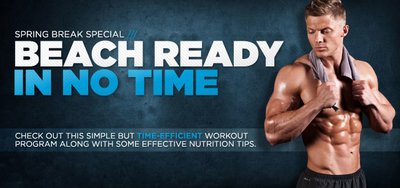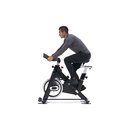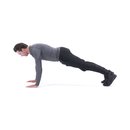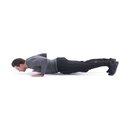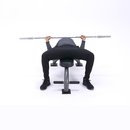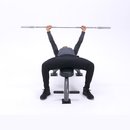Spring break and summer are times of opportunity, but only if you're prepared to succeed. Half the guys you know have been hitting the weights and leaning out for months now, so slacking puts you at a decided disadvantage, especially where the ladies are concerned. You're basically going to be choosing from among those girls who weren't able to attract the hot guys with the killer bods.
Fear not; we're here to help. For many, just getting back into an exercise routine can seem daunting, while for others, just getting past that weight loss or body fat plateau can seem insurmountable.
In this article, a simple but time-efficient workout program and a few effective nutrition tips will be revealed to illustrate the benefits of having a personal trainer on your side.
Cardio
This is by far the most important step in achieving goals of being lean and toned. In fact, ACSM recommends aerobic exercise be performed 3-5 days/wk, while resistance training be performed 2-3 days/wk. The point is, too often cardio is under-played, particularly by men.
However, for those who want to get in shape for spring break, summer or a wedding, cardio is key. It simply boils down to calories in vs. calories out. Aerobic exercise keeps the heart rate elevated continuously every time it is done, whereas with resistance training, heart rate being elevated continuously depends on the type and nature of the workout.
Additionally, aerobic exercise strengthens the most important muscle in the body, the heart. Cardio also helps to uncover the muscle underlying the subcutaneous fat. The range I recommend is 3-5 days a week for 20-60 minutes.
Cardio done 2 days a week is the absolute bare minimum, 3 days a week is adequate, 4 days a week is optimal, 5 days a week is a little better than optimal. The duration will be dependent on how each person responds.

{{caption}}
Additionally, aerobic exercise strengthens the most important muscle in the body, the heart.
Some people may get by on cardio 2-3 days a week at 20 minutes, many will be ok with 3-5 days a week at 20-40 minutes, while others may need 4-5 days a week at 30-60 minutes. For most people, 4-5 days a week for 20-45 minutes will be sufficient in reaching the previously listed goals.
As far as what type of cardio is optimal, high-intensity interval training (HIT) is by far, the most effective means of burning body fat during cardio (Talanian et al., 2007; Tremblay et al., 1994).
The ideal time would be first thing in the morning (Bennard et al., 2005; Wilcox et al., 1985), but if this is not comparable, 2-4 hours after your last meal (post-prandial meaning 2-4 hours after any previous meal) is the next best time (Galgani et al., 2006; Wu et al., 2003).
However, if none of these two approaches are comparable, doing the 4-5 times a week for 20-45 minutes will still be of great benefit to you (Blair et al., 1995; Pate et al., 1995).
Here's a cardio tactic that is very time-efficient and effective:
Cardio Workout
- 5-10 minute Warm-up
- 5-10 minutes of HIT (i.e. Jump Roping, interval Cycling, Boxing, Elliptical, Swimming, Running, Rowing, etc.)
Immediately follow HIT with:
- 10-25 minutes of continuous Aerobic Exercise (Treadmill, Bike, Elliptical, Swimming, etc.) at a lower intensity (i.e. 55%-70% of age-predicted max heart rate)
This would be ~ 20-45 minutes of total cardio.
Due to the interval training being vigorous, it should be limited to 1-2 days a week. The other 2-3 days moderate cardio (i.e. 55-70 % of age-predicted max heart rate) can be done.
Nutrition
Essentially, taking in fewer calories than one burns will lead to weight loss via fat loss. Reduce fat and carb intake slightly (replacing bad carbs and fats with good carbs and fats) while keeping protein normal to slightly higher.
Specifically, good carbs refers to eating unprocessed carbs like oatmeal, brown rice, legumes, fruit, veggies, etc.

{{caption}}
Reduce fat and carb intake slightly while keeping protein normal to slightly higher
Examples of bad carbs would be processed foods like candy, soft drinks, enriched flours/pastas, etc. Good fats include avocado, olive oil, nuts, etc.
Bad fats include processed foods with trans-fats, high-fat red meat, french fries from fast-food places, etc.
Here are some dietary tactics that are very time-efficient and effective:
Effective Dietary Tactics
- Reduce portion size of starch carbs and increase portion sizes of vegetables.
- Reduce sugar cravings by grabbing fruit instead of sweets.
- Eat a salad before dinner and add a little vinegar to the salad.
- Have a bowl of soup as an appetizer and maybe spice it with cayenne pepper.
- Add a protein shake as a small meal (classic and tasty recipe: organic fat-free milk, 1 banana, 2-3 tbsp wheat germ, 1-2 tbsp honey, 1/4 tsp cinnamon, 1-2 tbsp of naturally more peanut butter, 1/2 scoop of whey and/or soy protein, 1/4 tsp vanilla extract, 4 strawberries, frozen blueberries, top with handful of walnuts and/or almonds).
- Have a low-fat and low-sugar yogurt with some nuts and berries and sprinkle with cinnamon.
- Drink a cup of brewed Green Tea and/or white tea.
- Stay hydrated by drinking plenty of water.
Resistance Training
A common sight for me is seeing women spending most of their time doing cardio only, while others will do the same, but only allocate 5-10 minutes towards weights. And even still, it is not uncommon to see the use of 3-to-5-pound dumbbells being performed for all the exercises within that 5-10 minute span.
Several factors, but none more influential than the concern for "big muscles" drive this behavior. This occurrence is ironic in that although many women do not spend much time weight-training, this may be the single form of exercise keeping them from attaining that illustrious "muscle toned" look.
There are three main reasons why women will NOT get big and/or bulky muscles from resistance-training.
Reason 1
First of all, women do not produce the same amount of testosterone men do that give men the propensity for large muscles (Fahey, 2004).
Reason 2
A second and less known reason would be the law of reversibility (Fahey, 2004). Simply stated, if you do not use it, you lose it.
So if a woman were to see changes not to her liking, she could simply reduce the weight or just stop.
Reason 3
The third reason deals with muscle fiber type matching. It is generally recommended that the repetition range be 15-20 reps if the goal is muscle tone and endurance (Kravitz, 2007).
For most women, 8-15 reps will improve strength much better and provide a toner and tighter look. However, for those few who may respond differently, 15-20 reps would be your safe-haven.
The problem with doing cardiovascular training alone is that it burns fat, but it also can burn muscle. On the other hand, resistance training will give muscle a reason to remain.

{{caption}}
Resistance training will actually improve your body's fat-burning capability during cardiovascular exercise.
Thus, resistance training will actually improve your body's fat-burning capability during cardiovascular exercise by preventing muscle loss and accelerating fat loss.
As previously mentioned, ACSM recommends resistance training exercise be performed 2-3 days/wk.
Each resistance training exercise will be performed for 3 sets and the rep range will be 15-12-8 reps. With each set, weight is slightly increased. Each workout should last roughly 15-30 minutes.
Keep rest periods short by going to the next exercise right after the other until 3 sets for each exercise are done. Typically, if this is done right, your 2nd and 3rd rounds will test your recovery capacity and endurance.
Flexibility Training
All too often, stretching is neglected or down-played for its importance and relevance to overall health and fitness. I for one was guilty of such negligence at one point.
However, I have come full circle to realize the importance of stretching in the maintenance of functional range of motion and yes, injury prevention too.
Regardless of what some studies may state regarding stretching inhibiting muscle power (Kokkonen & Nelson, 1996; Nelson et al., 2001), that is such a moot point in regards to the overall benefits of stretching (Alter, 2004; Shrier, 2004; Worrell et al., 1994).
In fact, a recent study showed that being inflexible may actually be unhealthy (Yamamoto et al., 2009).
Stretching is something I definitely incorporate with my clients and I instruct them to do the stretches that are best suited for each person's flexibility needs.

{{caption}}
All too often, stretching is neglected or down-played for its importance and relevance to overall health and fitness.
Enhancing flexibility will improve recovery capability by definitely relieving the discomfort from any tension or muscle soreness from training and also it will help re-establish optimal muscle balance among all muscle groups.
ACSM recommends stretching be performed 2-3 days a week minimum. I tend to agree with that minimal level and for optimal results I recommend allotting at least 5-15 minutes at the backend of each workout to stretch.
Here is a simple but time-efficient and effective workout program:

BodyFit
$6.99/month- 2,500+ expert-created single workouts
- 3,500+ how-to exercise videos
- Detailed workout instruction
- Step-by-step workout tips
- Training at gym or at home
- Access to Workout Plans
- Access to Bodyfit App
- Store Discounts
Already have a Bodybuilding.com account with BodyFit? Sign In

What comes with BodyFit?

- Instructional Videos
Don't risk doing a workout improperly! Avoid injury and keep your form in check with in-depth instructional videos.

- How-to Images
View our enormous library of workout photos and see exactly how each exercise should be done before you give it a shot.

- Step-by-Step Instructions
Quickly read through our step-by-step directions to ensure you're doing each workout correctly the first time, every time.

BodyFit
$6.99/month- 2,500+ expert-created single workouts
- 3,500+ how-to exercise videos
- Detailed workout instruction
- Step-by-step workout tips
- Training at gym or at home
- Access to Workout Plans
- Access to Bodyfit App
- Store Discounts
Already have a Bodybuilding.com account with BodyFit? Sign In

What comes with BodyFit?

- Instructional Videos
Don't risk doing a workout improperly! Avoid injury and keep your form in check with in-depth instructional videos.

- How-to Images
View our enormous library of workout photos and see exactly how each exercise should be done before you give it a shot.

- Step-by-Step Instructions
Quickly read through our step-by-step directions to ensure you're doing each workout correctly the first time, every time.
Day 3: Cardio
First thing in morning, 2-4 hours post-prandial or what works for you.
- 5-10 minute Warm-up
- 10-35 minutes moderate-low intensity cardio (55-70% target HR)

BodyFit
$6.99/month- 2,500+ expert-created single workouts
- 3,500+ how-to exercise videos
- Detailed workout instruction
- Step-by-step workout tips
- Training at gym or at home
- Access to Workout Plans
- Access to Bodyfit App
- Store Discounts
Already have a Bodybuilding.com account with BodyFit? Sign In

What comes with BodyFit?

- Instructional Videos
Don't risk doing a workout improperly! Avoid injury and keep your form in check with in-depth instructional videos.

- How-to Images
View our enormous library of workout photos and see exactly how each exercise should be done before you give it a shot.

- Step-by-Step Instructions
Quickly read through our step-by-step directions to ensure you're doing each workout correctly the first time, every time.
Day 5: HIT Cardio
First thing in morning, 2-4 hours post-prandial or what works for you.
- 5-10 minute Warm-up
- 5-10 minutes HIT Cardio
- 10-25 minutes of moderate-low intensity Cardio (55-70% target HR)
Flexibility:
- 10-15 minutes Stretching of general tight areas
Days 6 and 7: Rest
Both of these days are rest days. However, you can stretch on these days to help recover and to improve flexibility.
In summary, cardio 4-5 days a week for 20-45 minutes, resistance training 2-3 days a week for 15-30 minutes, stretching 2-3 days a week minimum for 5-15 minutes and eating more fruits and vegetables.
Comprehensively on resistance training and cardio days, warm-up for 5-10 minutes with cardio, weights or bodyweight exercise for 15-30-minutes, cardio 10-30 minutes more and then 5-15 minutes stretching.
References:
- Alter M.J. (2004). Science of flexibility. 4th edition, Human Kinetics, Champaign, IL.
- American College of Sports Medicine (2000). ACSM's guidelines for exercise testing and prescription, (6th ed.). Baltimore: Lippincott Williams and Wilkins.
- Bennard et al. (2005). Maxmizing acute fat utilization: Effects of exercise, food, and individual characteristics, Canadian Journal of Applied Physiology, 30(4), 475-499.
- Bevegard et al. (1966). Circulatory adaptation to arm and leg exercise in supine and sitting position, Journal of Applied Physiology, 21(1), 37-46.
- Blair et al. (1995). Changes in physical fitness and all-cause mortality. A prospective study of healthy and unhealthy men, Journal of the American Medical Association, 273(14), 1093-1098.
- Corbin & Noble (1980). Flexibility: A major component of physical fitness, Journal of Physical Education and Recreation, 51(6), 23-24, 57-60.
- Fahey, T.D. (2005). Basic Weight Training For Men and Women, 5th edition, The McGraw-Hill Companies, Inc., New York, NY.
- Franklin, B.A. (1985). Exercise testing, training, and arm ergometry, Sports Medicine, 2(2), 100-119.
- Galgani et al. (2006). Acute effect of meal glycemic index and glycemic load on blood glucose and insulin responses in humans, Nutrition Journal, 5, 22.
- Kokkonen & Nelson (1996). Acute stretching exercises inhibit maximal strength performance, Medicine and Science in Sports and Exercise, 28(5), (Suppl. 190).
- Kravitz, L. (2007). All About Muscles and How Best to Train Them, ACSM's 11th Health & Fitness Summit & Exposition, Dallas, TX.
- Marieb, E.N. (1998). Human Anatomy & Physiology, 4th edition, Benjamin/Cummings Science Publishing, Menlo Park, CA.
- Nelson et al. (2001). Inhibition of maximal voluntary isokinetic torque production follwing stretching is velocity-specific, Journal of Strength and Conditioning Research, 15(2), 241-246.
- Pate et al. (1995). Physical activity and public health. A recommendation from the Centers for Disease Control and Prevention and the American College of Sports Medicine, Journal of the American Medical Association, 273(5), 402-407.
- Shrier, I. (2004). Does stretching improve performance? A systematic and critical review of the literature, Clinical Journal of Sports Medicine, 14(5), 267-273.
- Stenberg et al. (1967). Hemodynamic response to work with different muscle groups, sitting and supine, Journal of Applied Physiology, 22(1), 61-70.
- Talanian et al. (2007). Two weeks of high-intensity aerobic interval training increases the capacity for fat oxidation during exercise in women, Journal of Applied Physiology, 102(4), 1439-1447.
- Tremblay et al. (1994). Impact of exercise intensity on body fatness and skeletal muscle metabolism, Metabolism, 43(7), 814-818.
- Wilcox et al. (1985). The effect of fasting on fat utilization during running, Medicine and Science in Sports and Exercise, 17 (2), suppl 258.
- Worrell et al. (1994). Effect of hamstring stretching on hamstring muscle performance, Journal of Orthopaedic and Sports Physical Therapy, 20(3), 154-159.
- Wu et al. (2003). The influence of high-carbohydrate meals with different glycaemic indices on substrate utilisation during subsequent exercise, British Journal of Nutrition, 90 (6), 1049-1056.
- Yamamoto et al. (2009). Poor trunk flexibility is associated with arterial stiffening, American Journal of Physiology: Heart and Circulatory Physiology, 297(4), H1314-H1318.


